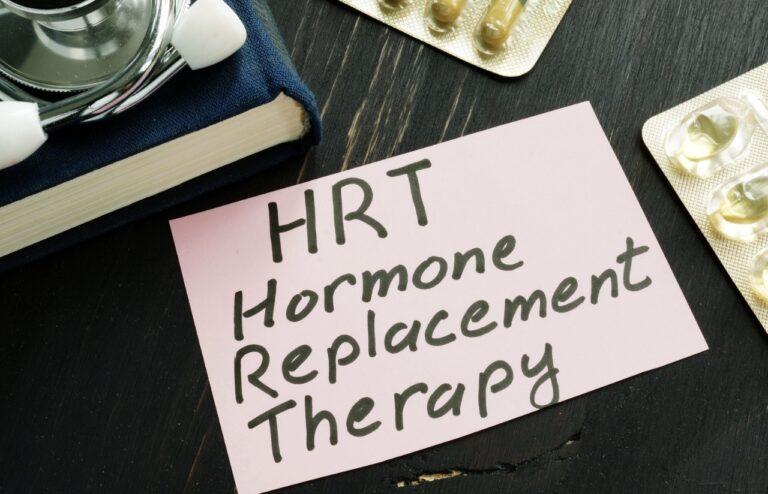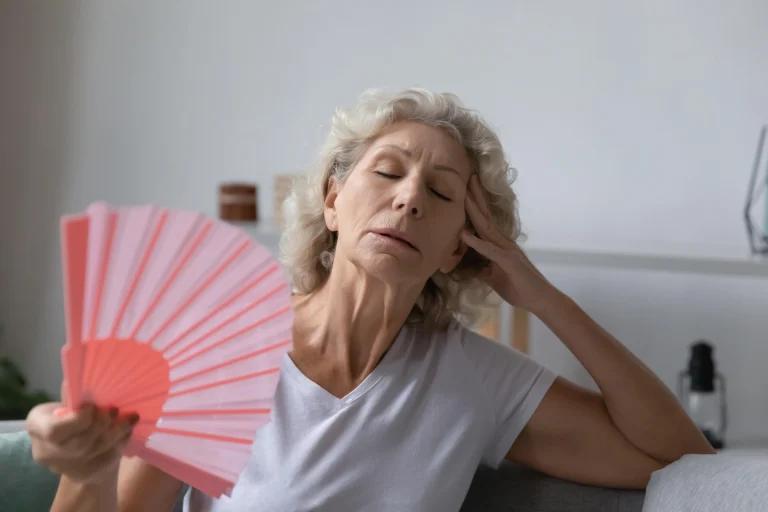
October 15, 2025 (Current Version)
March 28, 2025
Hormone Replacement Therapy (HRT) has long been a topic of debate and concern for many women experiencing menopause. The controversy surrounding its safety has left women confused and hesitant to consider this treatment option. However, recent evidence suggests that the risks associated with HRT are very low, and the benefits often outweigh the potential drawbacks. In this article, we will delve into the benefits and risks of HRT, providing a comprehensive overview to help you make an informed decision.
The importance of hormones in menopause
HRT consists of replacing the hormones that your body produces less of as you go through menopause. These hormones, mainly estrogen and progestogen, play a vital role in regulating various bodily functions, including menstrual cycles, ovulation, pregnancy, and bone health.
Understanding hormone replacement therapy
HRT, also known as hormone therapy, involves the use of medication containing female hormones. It is primarily used to replace the estrogen that the body stops producing during menopause. By replenishing estrogen levels, HRT helps alleviate common symptoms of menopause such as hot flashes, night sweats, sleep disturbances, anxiety, and vaginal dryness.
Types of HRT
HRT can be categorised into two main types: Combined HRT and estrogen-only HRT. The choice between the two depends on factors such as whether you have had a hysterectomy, the stage of menopause you are in, and personal preferences.
Estrogen-only HRT for women with a hysterectomy
If you have had a hysterectomy, which involves the removal of the womb, estrogen-only HRT is typically recommended. Since the uterus has been removed, there is no need for progestogen to protect against the risk of womb cancer. Estrogen can be taken in various forms, including tablets, patches, sprays, or gel.
Combined HRT for women with an intact uterus
If you still have your uterus, you will generally need to take both estrogen and progestogen. This combination helps protect against the risk of womb cancer. Estrogen can be obtained from tablets, patches, spray, or gel, while progestogen can be taken orally or administered using an intrauterine system (IUS) such as the Mirena coil. Alternatively, you can opt for an HRT product that already contains both estrogen and progestogen.
Different forms of HRT
HRT is available in various forms, each with its advantages and disadvantages. It may be necessary to try different brands and methods to find the one that suits you best. Let’s explore some of the most common forms of HRT:
Tablets
Tablets are one of the most common forms of HRT. They are typically taken once a day and are available for both estrogen-only and combined HRT. Taking tablets is convenient and easy, but it is worth noting that some risks associated with HRT, such as blood clots, are higher with tablets compared to other forms.
Patches
Skin patches are another popular option for HRT. Patches are applied to the skin, typically on the lower part of the body, and gradually release hormones into the bloodstream. Patches are changed every few days, depending on the brand. They are available for both estrogen-only and combined HRT. Patches are a good alternative for those who have difficulty swallowing tablets or are prone to forgetting to take medication. Additionally, patches have a lower risk of blood clots compared to tablets.
Estrogen gel
An increasingly popular form of HRT is estrogen gel. This gel is applied to the skin once a day, and the hormone is absorbed gradually. Estrogen gel is suitable for women who have not had a hysterectomy, but it must be used in combination with progestogen. The gel is an effective option for those who cannot take tablets and carries a lower risk of blood clots.
Spray
For women who cannot take tablets or prefer an alternative, an estrogen-only spray is available. The spray is applied once a day, typically on the inner side of the arm or thigh. Like estrogen gel, it does not increase the risk of blood clots. However, it is important to wait for at least an hour before bathing or showering after using the spray.
Intrauterine system (IUS) or Mirena coil
The Mirena coil, an intrauterine system (IUS), is an option for women who have a uterus and are taking estrogen tablets, patches, gel, or spray. The Mirena coil is inserted into the womb, where it gradually releases a form of progestogen called levonorgestrel. It can stay in place for up to 5 years and acts as both contraception and a way to deliver progestogen for HRT. The Mirena coil is particularly beneficial for those who do not want to take medication daily or have difficulties with other forms of progestogen. However, it may cause abdominal pain and bleeding as side effects.
Vaginal estrogen
Low-dose estrogen is available in the form of a cream, gel, vaginal tablet, pessary, or ring that is inserted into the vagina. These products can help alleviate menopausal symptoms such as vaginal dryness, burning sensation, or pain during intercourse. Vaginal estrogen does not carry the usual risks associated with HRT and does not increase the risk of breast cancer. It can be used without taking progestogen, even if the woman still has a uterus. However, it does not provide relief for other menopausal symptoms such as hot flushes or mood swings.
Testosterone
In addition to estrogen and progestogen, the hormone testosterone also decreases during menopause, albeit gradually. This decline in testosterone levels can lead to symptoms such as fatigue, mood changes, and a decreased sex drive. While testosterone is not currently licensed for the treatment of menopausal symptoms, a specialist doctor may prescribe it in certain cases, particularly for post-menopausal women with low sex drive. Testosterone comes in the form of a gel and can have side effects such as acne, unwanted hair growth, and weight gain.
Tibolone
Tibolone, also known by its brand name Livial, is a prescription medicine that combines the effects of estrogen, progestogen, and testosterone. It is taken orally once a day and can help relieve symptoms such as hot flushes and low mood. While studies have suggested that tibolone may not be as effective as combined HRT, it can be a suitable option for women who have not had a period for more than a year.
The benefits of hormone replacement therapy
HRT offers several benefits to women experiencing menopause. Let’s explore them in detail:
Relieving menopause symptoms
One of the primary benefits of HRT is its effectiveness in alleviating various menopausal symptoms. Women often experience bothersome hot flashes, night sweats, sleep disturbances, and mood changes during this transitional phase. HRT can provide significant relief from these symptoms, improving overall quality of life. Most women notice a reduction in symptoms within a few days or weeks of starting HRT.
Preventing osteoporosis
Osteoporosis, characterized by the thinning of bones, is a common condition that occurs after menopause due to decreased estrogen levels. HRT helps prevent osteoporosis by increasing estrogen levels, which are essential for maintaining healthy bones. This benefit is particularly important for women who experience early menopause or have a higher risk of developing osteoporosis. However, it’s worth noting that doctors may recommend additional medications called bisphosphonates for the treatment of osteoporosis.
Maintaining muscle strength
As women approach menopause, it’s common for them to experience a decline in muscle strength. HRT has been shown to improve muscle strength and help preserve muscle mass. However, it’s important to complement HRT with regular exercise and physical activity to ensure optimal muscle health.
The risks of hormone replacement therapy
While the risks associated with HRT are generally low, it’s crucial to consider them before making a decision. Here are the potential risks to be aware of:
Breast cancer
One of the concerns regarding HRT is its potential association with an increased risk of breast cancer. However, recent studies have shown that the risk is relatively low, especially when considering the benefits it offers. For every 1,000 women taking combined HRT (estrogen and progestin) for five years, there may be around five additional cases of breast cancer. It’s important to note that the risk increases with prolonged use of HRT and decreases after discontinuation.
Blood clots
HRT, particularly when taken in tablet form, can slightly increase the risk of blood clots. However, this risk remains very low. To lower risk, doctors often recommend alternative forms of HRT such as patches, gels, or sprays, as these methods do not pose the same clotting risk.
Stroke
HRT tablets, but not patches, gels, or sprays, have been associated with a slight increase in the risk of stroke. However, the risk remains minimal, especially for women under the age of 60. It’s important to discuss your risk factors with your doctor to determine the most suitable form of HRT.
Making an informed decision
When considering HRT, it’s essential to weigh the benefits against the potential risks based on your circumstances. Factors such as age, menopause symptoms, and your personal health history are crucial in determining whether HRT is a suitable option for you.
Who can benefit from hormone replacement therapy?
HRT may be beneficial for the following groups of women:
- Women with moderate to severe menopausal symptoms: If you experience significant hot flashes, night sweats, or other bothersome symptoms, HRT can provide significant relief
- Women with vaginal symptoms: HRT can effectively address vaginal dryness, itching, burning, and discomfort during intercourse, improving overall sexual health and well-being
- Women at risk of osteoporosis: If you have a higher risk of developing osteoporosis, such as experiencing early menopause or having a family history of the condition, HRT can help protect against bone loss
- Women with early menopause or estrogen deficiency: If you’ve had your ovaries surgically removed before the age of 45 or experienced early menopause, HRT can help decrease the risk of certain health conditions associated with estrogen deficiency, including osteoporosis, heart disease, stroke, dementia, and mood changes
Reducing risk with hormone replacement therapy
To minimise the potential risks associated with HRT, it’s important to follow these guidelines:
- Find the most suitable product and delivery method: Discuss with your doctor the various options available, such as pills, patches, gels, creams, or sprays. Choose the delivery method that offers the most benefits with the least risks and inconvenience
- Use the lowest effective dose: Take the lowest dose of HRT that effectively manages your symptoms. This helps minimize the potential risks associated with long-term use
- Regular follow-up care: Schedule regular check-ups with your doctor to ensure that the benefits of HRT continue to outweigh the risks. These appointments also provide an opportunity for necessary screenings, such as mammograms and pelvic exams
- Maintain a healthy lifestyle: Adopting a healthy lifestyle can further reduce the risks associated with menopause. Engage in regular physical activity and exercise, follow a balanced diet, maintain a healthy weight, avoid smoking, limit alcohol consumption, manage stress, and address any chronic health conditions you may have
Exploring alternative options
If you’re unable to take HRT or prefer non-hormonal alternatives, there are other options available to manage menopausal symptoms.
- Lifestyle changes: Making certain lifestyle adjustments can help alleviate symptoms. These include wearing lightweight clothing, using fans or air conditioning to stay cool, limiting the consumption of caffeine and alcohol, practising relaxation techniques, and maintaining a healthy sleep routine
- Non-hormonal medications: There are non-hormonal prescription medications that may help relieve specific menopausal symptoms, such as hot flashes. Consult your doctor to determine if these medications are suitable for you
- Vaginal moisturizers and lubricants: For vaginal dryness and painful intercourse, using vaginal moisturisers or lubricants can provide relief. Additionally, your doctor may prescribe medications specifically designed to address these concerns
Conclusion
When considering hormone replacement therapy (HRT), it’s essential to weigh the benefits against the potential risks based on your circumstances. Recent evidence suggests that the risks associated with HRT are generally low, especially when used for a shorter duration and in younger women. HRT is an effective treatment to alleviate menopausal symptoms, prevent osteoporosis, and maintain muscle strength. However, it’s important to discuss your personal medical history and risk factors with your doctor to make an informed decision. Remember that there are alternative options available if HRT is not suitable for you. By understanding the benefits and risks of HRT, you can navigate the menopausal journey with confidence and make choices that prioritise your overall well-being.
Sources
- Hormone therapy: Is it right for you? – Mayo Clinic
- Benefits and risks of hormone replacement therapy (HRT) – NHS
Medical Disclaimer
NowPatient has taken all reasonable steps to ensure that all material is factually accurate, complete, and current. However, the knowledge and experience of a qualified healthcare professional should always be sought after instead of using the information on this page. Before taking any drug, you should always speak to your doctor or another qualified healthcare provider.
The information provided here about medications is subject to change and is not meant to include all uses, precautions, warnings, directions, drug interactions, allergic reactions, or negative effects. The absence of warnings or other information for a particular medication does not imply that the medication or medication combination is appropriate for all patients or for all possible purposes.







